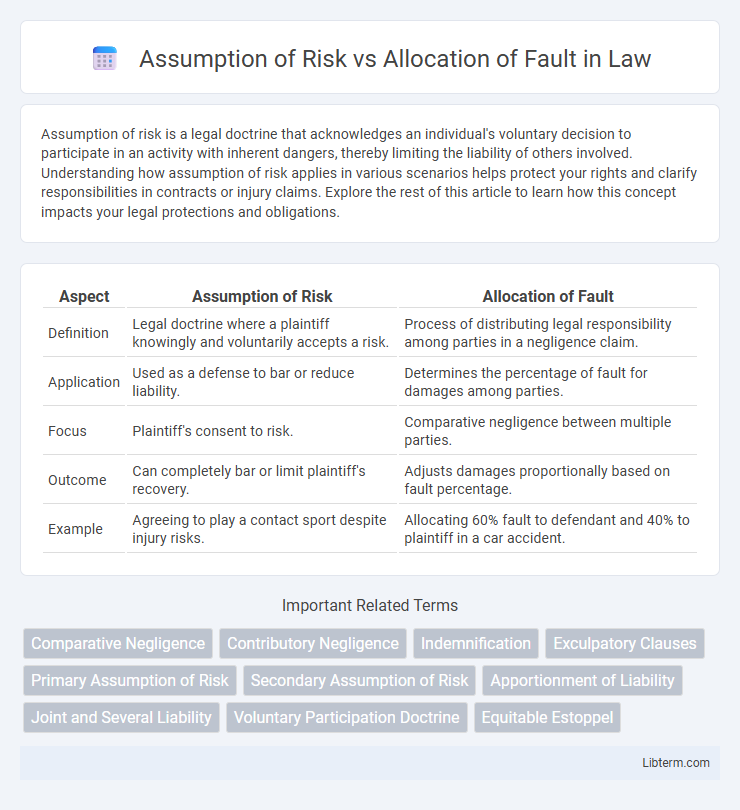Assumption of risk is a legal doctrine that acknowledges an individual's voluntary decision to participate in an activity with inherent dangers, thereby limiting the liability of others involved. Understanding how assumption of risk applies in various scenarios helps protect your rights and clarify responsibilities in contracts or injury claims. Explore the rest of this article to learn how this concept impacts your legal protections and obligations.
Table of Comparison
| Aspect | Assumption of Risk | Allocation of Fault |
|---|---|---|
| Definition | Legal doctrine where a plaintiff knowingly and voluntarily accepts a risk. | Process of distributing legal responsibility among parties in a negligence claim. |
| Application | Used as a defense to bar or reduce liability. | Determines the percentage of fault for damages among parties. |
| Focus | Plaintiff's consent to risk. | Comparative negligence between multiple parties. |
| Outcome | Can completely bar or limit plaintiff's recovery. | Adjusts damages proportionally based on fault percentage. |
| Example | Agreeing to play a contact sport despite injury risks. | Allocating 60% fault to defendant and 40% to plaintiff in a car accident. |
Introduction to Assumption of Risk and Allocation of Fault
Assumption of risk involves a party voluntarily accepting the known dangers associated with an activity, thereby limiting liability in personal injury cases. Allocation of fault, also known as comparative negligence, assigns responsibility among involved parties based on their respective contributions to the harm or accident. Understanding how courts differentiate between these concepts is essential for analyzing liability and damages in tort law.
Defining Assumption of Risk
Assumption of Risk refers to a legal doctrine where an individual voluntarily and knowingly assumes the inherent dangers of a particular activity, thereby limiting liability for potential injuries. It requires clear evidence that the person understood and accepted the risks before engaging in the activity. This concept contrasts with Allocation of Fault, which deals with determining the degree of responsibility among parties after an injury occurs.
Understanding Allocation of Fault
Allocation of fault refers to the legal process of determining the degree of responsibility each party holds in causing an injury or damage. This concept is crucial in tort law, where courts assign percentages of fault to involved parties, influencing compensation amounts in negligence claims. Understanding allocation of fault helps clarify how liability is divided, particularly in comparative negligence jurisdictions.
Key Differences Between the Doctrines
Assumption of risk requires a plaintiff to knowingly and voluntarily accept the dangers inherent in a particular activity, thereby limiting or barring recovery for resulting injuries. Allocation of fault distributes responsibility among all parties involved in an incident based on their comparative negligence, impacting the proportion of damages each must pay. While assumption of risk focuses on the plaintiff's consent to risk, allocation of fault centers on assigning liability according to each party's degree of fault.
Legal Applications in Personal Injury Cases
Assumption of risk involves a plaintiff knowingly and voluntarily engaging in an activity with inherent dangers, thereby limiting liability for defendants in personal injury cases. Allocation of fault, often governed by comparative or contributory negligence laws, determines the degree of responsibility each party holds for the plaintiff's injuries. Courts apply these doctrines to assess damages and liability, influencing settlement negotiations and trial outcomes in personal injury litigation.
Impact on Plaintiff and Defendant Liability
Assumption of Risk limits plaintiff recovery by acknowledging they knowingly accepted potential dangers, reducing defendant liability when proven. Allocation of Fault divides responsibility proportionally among parties, directly impacting the plaintiff's compensation based on their degree of fault. Courts use these doctrines to balance liability, often decreasing defendant obligations if the plaintiff's conduct contributed significantly to the harm.
Comparative and Contributory Negligence Explained
Comparative negligence reduces a plaintiff's damages award based on their percentage of fault, while contributory negligence bars recovery entirely if the plaintiff is even slightly at fault. Assumption of risk involves knowingly and voluntarily engaging in a dangerous activity, which can limit or eliminate liability. Allocation of fault determines how damages are distributed among parties, with comparative negligence often resulting in proportional reductions, contrasting with the all-or-nothing approach of contributory negligence.
Case Law Illustrating Both Doctrines
Case law demonstrates how courts apply Assumption of Risk by recognizing that plaintiffs who voluntarily engaged in known hazards may be barred from recovery, as seen in Murphy v. Steeplechase Amusement Co. Allocation of Fault, illustrated in comparative negligence cases like Li v. Yellow Cab Co., involves dividing damages between parties based on their respective degrees of fault to achieve equitable outcomes. These doctrines underscore the judicial balancing act between personal responsibility and liability in tort law, shaping precedent on injury compensation.
Jurisdictional Variations and Trends
Jurisdictional variations in assumption of risk and allocation of fault significantly impact liability determinations in tort cases, with some states adopting comparative negligence standards while others emphasize contributory negligence doctrines. Trends indicate a growing preference for comparative fault systems that allocate damages proportionally based on each party's degree of fault, reflecting a shift away from strict assumption of risk defenses. Courts increasingly analyze statutory modifications and case law to balance plaintiffs' responsibilities with defendants' duties, influencing outcomes in personal injury and product liability claims.
Practical Implications for Legal Strategy
Assumption of risk and allocation of fault play crucial roles in legal strategy by influencing case outcomes and liability distribution. Understanding assumption of risk helps defense counsel argue that the plaintiff knowingly exposed themselves to danger, potentially reducing or eliminating liability. Allocation of fault enables lawyers to strategically apportion damages among parties, leveraging comparative negligence doctrines to minimize client exposure and optimize settlement negotiations.
Assumption of Risk Infographic

 libterm.com
libterm.com